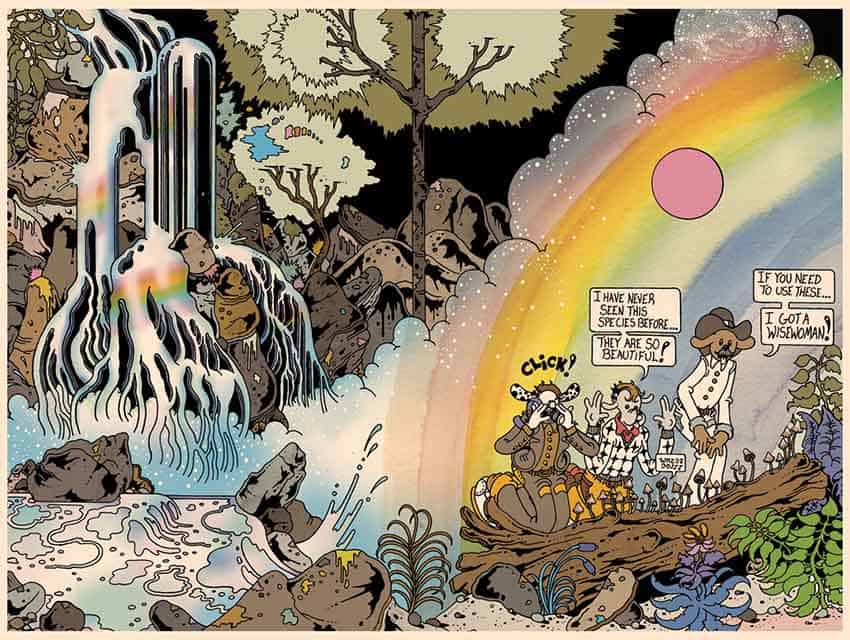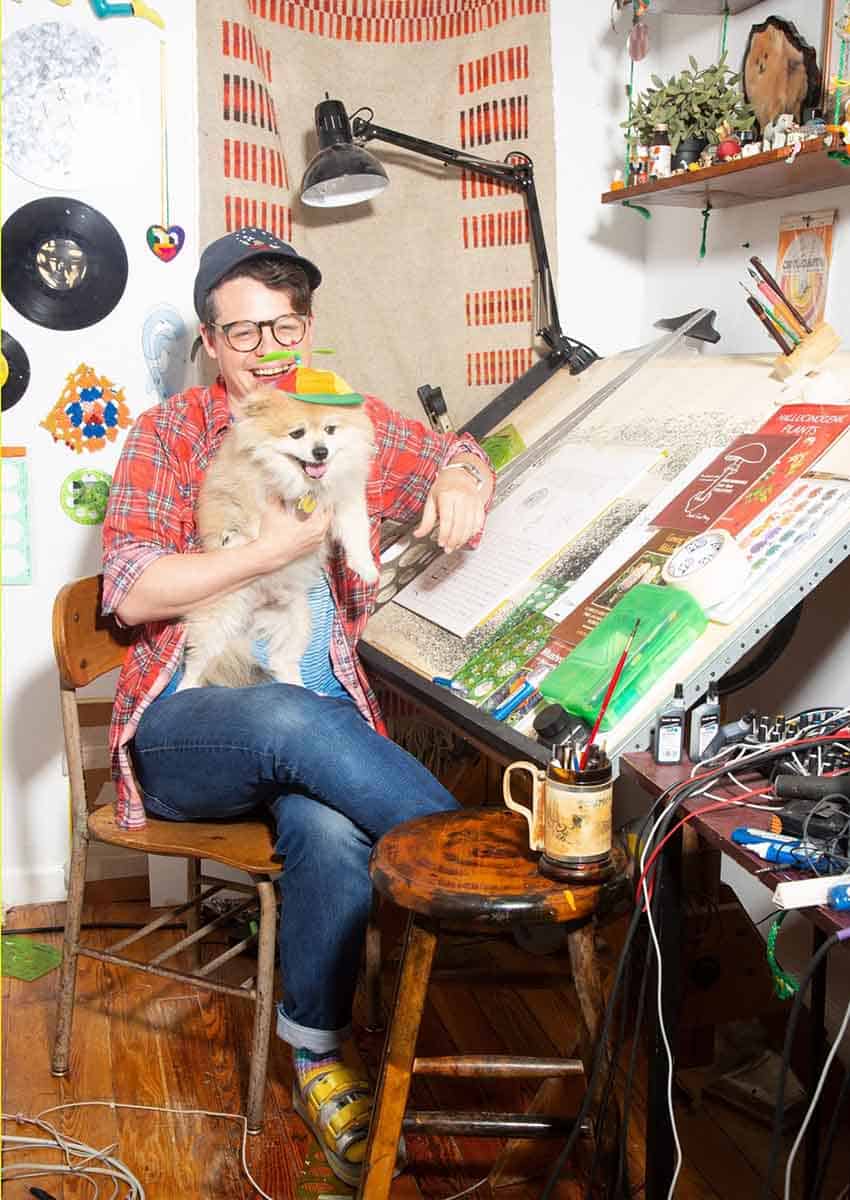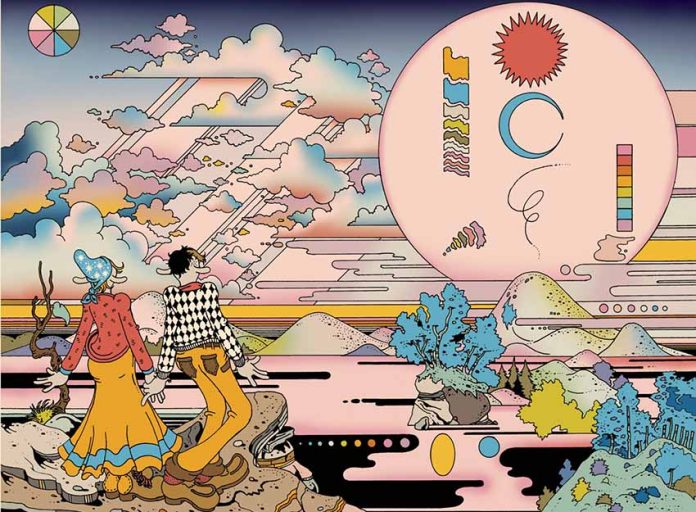Talking mushrooms – part of a psilocybin trip? Not quite. In a recent graphic novel about a real-life couple’s groundbreaking research into magic mushrooms in Mexico, writer and artist Brian Blomerth frequently depicted the mushrooms in the background, and even invented a language for them.
These mushrooms are the star supporting characters of “Brian Blomerth’s Mycelium Wassonii.” Published in late 2021, the book reintroduces readers to Robert Gordon Wasson (better known as R. Gordon Wasson) and his wife Valentina Wasson, amateur scientists whose research in the 1950s included multiple visits to Oaxaca, where they explored mushroom use among the indigenous Mazatec people.
Regarding the mushroom language he created, Blomerth said, “It is translatable into English.” But he says of anyone who can manage the feat, “You’re going to be wildly disappointed.”
His book does not disappoint in chronicling the Wassons, who are credited as the founders of a new scientific field – ethnomycology. Their research piqued the interest of the era’s prominent magazines – as well as the CIA.
Acclaimed mycologist Paul Stamets, who wrote the foreword to Blomerth’s book, singled out two women for particular praise in the narrative: Valentina “Tina” Wasson, and a Mazatec shaman and curandera named María Sabina.
“History must give Tina proper credit,” Stamets wrote. “She was the mycologist in [the Wassons’] relationship, not to mention an early pioneer in noting that psilocybin could be helpful in treating psychiatric health challenges.”

Sabina “so graciously shared indigenous traditions with the Wassons and many others,” he added.
Although the United States banned research into psychedelics in the 1970s, recent science has put them back on the map.
Asked about present-day research, Blomerth said, “I’m not entirely qualified and definitely not a source for this kind of stuff.”
However, he added, “You can read multiple articles about the [2022] Johns Hopkins study of near-death experiences and pre-death experiences with psilocybin.”
“I think it’s good,” he said of such initiatives. “I’m all for it … It’s not a bad thing to research and investigate.”
Blomerth has a longstanding interest in the subject. A previous graphic novel, “Brian Blomerth’s Bicycle Day,” chronicled the story of Albert Hofmann and LSD.
Hofmann allegedly discovered LSD on a memorable bike ride in 1943. In both “Bicycle Day” and “Mycelium Wassonii,” Blomerth focused on protagonist couples – Albert and Anita Hofmann, and the Wassons.
Blomerth noted that the two couples actually went on a research trip to Mexico together, a fact not shown in the book. And Albert Hofmann has a further Mexico connection.
“Wasson sent samples of mushrooms he got from Mexico to Hofmann,” Blomerth said. “Hofmann isolated psilocybin from them. That’s a connection to the story as well.”
The memorable artwork in Blomerth’s book often seems evocative of a psychedelic experience. During a trance scene at the home of Mazatec curandera Sabina, the upper right-hand corner of the page seems to peel off and a whimsical, globe-like creature steps through. The concrete darkness of the room dissolves into bright, dreamlike images.
“I see the words fall like little luminous objects from heaven,” María says as lines of text float through space, then get replaced by watercolor images of a jaguar, a bird and a mushroom.
The story begins on the Wassons’ 1927 honeymoon in Ulster County, New York. Valentina finds wild chanterelles, which bring back memories of meals in her native Russia. She collects and cooks the Catskills variety. Initially repulsed, her husband adopts her viewpoint, thanks to an intensely tasty breakfast.

By day, Robert works on Wall Street for J.P. Morgan. Off the clock, he heads to the New York Public Library to research his new interest and corresponds with fellow enthusiast Robert Graves, the creator of I, Claudius, which explored the historical mystery of whether or not the Roman emperor Claudius was poisoned by mushrooms.
Graves mentions to Robert the ethnobotanist Richard Evans Schultes, who researched the Mazatecs and their use of mushrooms.
The book depicts two of the couple’s trips to Huautla de Jiménez, Oaxaca, in 1953 and 1955. Blomerth depicts Mazatec characters communicating in their tonal language that incorporates whistling.
“I watched a linguist who lived with them for a while and did a couple of interviews,” Blomerth said. “The whistle language is really, really fascinating…”
One challenge he had in writing the book was deciding how to show the Mazatecs’ environs in the cloud forests of the Sierra Mazateca.
“Basically, it’s a dense jungle. I wanted to showcase certain plants. I figured out a general idea of the plants that grow there and kind of combined all the areas.”
He expressed admiration for the cloud forests. “[It’s] tons of green vegetation on top of a hill, vegetation-rich, so high up.”
Back home, the CIA is intrigued by the power of psychedelics and offers to assist Robert with his research. When he rebuffs them, they surreptitiously tap into his work — using a front organization that gives him a grant.
“They did send him a check, a small amount of money, from a fake company,” Blomerth said. “I did sense he wasn’t into what they were thinking, from everything I read. It’s a little shrouded, as these things are.”
In 1957, the Wassons share perspectives on their research in the media — Robert for Life magazine, Valentina for the now-defunct nationally syndicated Sunday newspaper supplement, This Week.
Yet this is all overshadowed by the devastating news that Valentina has cancer. She dies the next year, in 1958. Blomerth poignantly notes the impact of her passing on her husband.
The book also shows the fallout from mushrooms’ sudden popularity: a hippie trail heading to Huautla de Jiménez. A crowd of Mazatecs lament the disrespect shown by the newcomers. María’s house burns down in mysterious circumstances.

As for the mushrooms, they have their own final say in the narrative — and the conversation is ongoing.
“Maybe they will speak again — as medicine,” María says in a final panel, standing over some talking mushrooms.
Rich Tenorio is a frequent contributor to Mexico News Daily.
